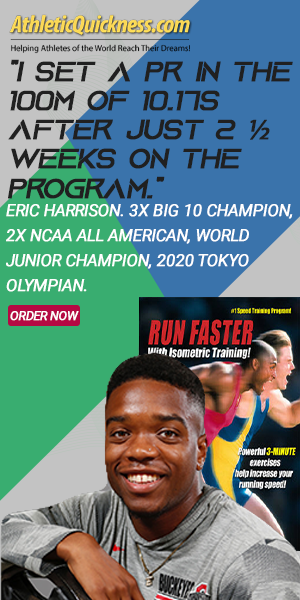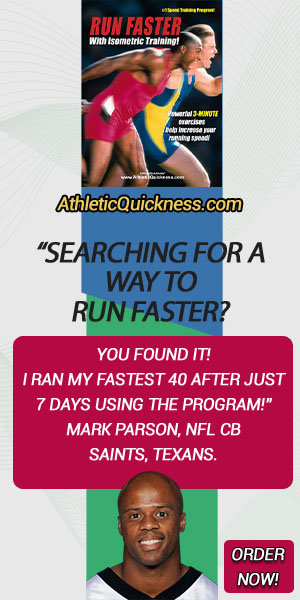WOW! THAT GUY HAS A STRONG LEG!
Why is the smallest guy on the team getting credit for having
the strongest leg on the team?
Attention Football Kickers and Soccer Players
– Kick farther and run faster than ever before
– Get started with your own Speed Training Program
We’ve all seen and heard it before. You are watching a good football game, and a punter, backed up into his own end zone, drills a 70 yarder dashing any hope of the opposing team working with a short field. Or, just before halftime or the end of a game, a place kicker nails a 55+ yarder. And what do we hear from the commentators? “Wow, that guy has a strong leg!”
Standing 6’1″ and weighing 175 pounds soaking wet, I can tell you as a former kicker myself that I did not have the strongest leg on my team. In fact, I would be willing to bet that I had the weakest leg on my team with respect to physical strength in the weight room. Yet, everyone thought I had a strong leg.
Early on in my career this was flattering to hear. But, behind the scenes, and especially in the weight room, everyone knows the offensive and defensive linemen are the real strong men — the ones with legendary feats of strength. But the funny thing is, you never hear anyone praising them for having a strong leg.
Maybe you’ve heard of Paul McFadden, who kicked for the NFL Philadelphia Eagles and was 1985 NFC rookie of the year. Paul was a few years older than me, and we practiced together for a season at Youngstown State. If anyone is a good example of kickers having a fast leg but not especially strong, it was Paul. I don’t think his playing weight was more than 160 pounds, at 5’10” tall.
So there are two questions you have to ask yourself are:
1) If the linemen have the strongest legs on the team, why aren’t they doing the kicking?
2) Does the kicker really have a strong leg, or is it a more appropriate to ask if the kicker really has a quick or fast leg?
The answer is: Punters and kickers have quicker muscular contraction rates in the muscles responsible for punting and kicking than a linemen trying to perform the same skill.
Or in other words, the leg muscles of kickers accelerate the speed of the leg much faster.
Therefore when the foot meets the ball, the leg of the kicker is moving much faster than the leg of the lineman.
That’s why those with the strongest leg muscles don’t necessarily kick the ball farther.
This boils down to a simple physics equation. If you took a physics class , then you might remember that
F=MA or Force (F) = Mass (M) x Acceleration (A).
If we put aside for the moment that punting and kicking are specialized skills involving timing and ball placement on the kicker’s foot, the distance that a ball travels is directly related to the amount of mass (M) striking the ball times the amount of acceleration (A) or, speed.
Now I don’t think there is much argument in the fact that an offensive or defensive lineman’s leg and foot have more mass than the average kicker’s, so we will credit them for that. So then, the difference in the amount of force (F) generated has to be in the amount of speed/acceleration (A) that a kicker’s leg and foot have at impact into the ball.
And, I am willing to bet that the average kicker can swing his leg between 2 and 5 times faster than the average lineman, and this is more than enough of a difference to compensate for any difference of physical strength in the weight room, thus resulting in a greater ability to kick a ball.
So where does this leg speed come from?
To get started in developing fast kicking muscles consider first the muscle groups involved in performing a punt or kick. The muscles involved in punting are the Thigh/hip flexors and Quadriceps.
And, for performing a soccer style kick, include the Adductors.

Thigh flexors or hip flexors. (See Arrow)
Main function is to raise your leg and swing it forward.
The Quadricpes are located on top of the thigh above the knee
and swing the lower leg forward.
The speed of these muscles does not come in the weight room.
It never has and never will, and kicking a ball very far is proof of that.
There are two keys to getting more speed in your kicking leg.
First, is knowing how to condition your muscles for speed.
Muscles are composed of basically two fiber types. One type (slow twitch fibers) for strength and endurance, the ability to move against heavy resistance and to perform repetitions without tiring. And another type of fiber (fast twitch fibers) for speed and fast muscle contractions.
The speed comes by conditioning the fast twitch muscle fibers in your leg muscles to perform what is called a ‘fast twitch response’ – which basically means to contract with speed and acceleration.
The bottom line is you cannot condition your muscles for speed using the same techniques you use to train for strength. You may think you are making your muscles faster with strength training but your muscles will know the difference.
This is what most coaches, athletes and trainers have not grasped; and this is why athletes are often disappointed with their speed training results.
What we have discovered is that muscles are best conditioned for speed using a strategy of isometric exercises with resistance bands.
This is a training technique that by it’s very nature transfers speed qualities back into the muscles that are opposing them.
Isometrics using the resistance band, the way we teach it, will unlock the blazing speed and quickness of your fast twitch fibers.
Once you start to exercise your muscles using this type of training, you will likely discover that up until now those muscles have been underdeveloped, and you will notice dramatic increases in your speed and kicking distance in a matter of days.
The second key to leg speed is knowing precisely which muscles to condition.
The thigh flexor is a primary muscle group responsible for leg speed in punting and kicking. Proper conditioning of the thigh flexor muscle will add additional yardage to your punts and kicks. This same principle applies to the quadriceps and adductors.
Collectively as a group, the thigh flexors are among the strongest muscle groups in the body – yet they are largely ignored in most training programs.
Ironically, in spite of their incredible inherent strength, if you are like most athletes then your thigh flexors are also greatly underdeveloped for their full potential for speed.
The reality is that a lot of athletes, trainers and coaches are simply unaware of the importance of the thigh flexor muscles.
There can be many reasons why. Maybe it’s because at the gym there is typically not any single weight machine that can effectively condition these muscles and therefore they go unnoticed.
Maybe it’s because you really can’t see them since they are located deep in the anterior hip region further adding to their obscurity. Or perhaps people do not understand their importance or that they think they are training them when they really aren’t. But for whatever reason the thigh flexors are largely ignored.
With weak and slow thigh flexors, your kicking ability will be significantly affected more than you could ever imagine.
The only way I have ever been able to effectively isolate the thigh flexors is with resistance bands. No other method is more effective. The only way I have ever been able to increase their contraction velocity is with isometric training. Again, No other method is more effective.
The hip flexor muscles along with the quadricpes form the foundation for dramatically improving your kicking distance. This same principle also applies to the adductors which are important for soccer style kicking.
This combination of using the resistance band with an isometric training strategy, the way we teach it, on your core sprinting muscles is the secret to getting faster than ever before.
These exercise can be done basically anywhere. You don’t need to go to the gym to do it. You can do these exercises in the privacy of your own home in just a few minutes (like 15 minutes or less) a day.
And unless you have applied isometric training to your thigh muscles using the resistance band, you have a huge reservoir of untapped muscular energy just waiting to be released!
In addition the thigh flexor muscles are also the primary muscle group responsible for sprinting speed – so by conditioning your thigh flexor for speed you will see dramatic improvements in your sprinting speed as well as your kicking abilities – even if you are already a top performer.
By doing the exercises the way we show you, you can’t help but improve your athletic performance and stand out from the crowd.
Dr. Larry Van Such
Muscle Speed Expert
Our guarantee is very simple
If this program does not significantly increase your muscle speed and quickness, and improve your athletic performance in soccer or football we will gladly refund 100% of the cost. No questions asked.
Skip the learning part and go straight to the doing part
Start kicking farther and running faster than ever before – in just days, not weeks or months.
Order the Run Faster and Kick Farther Speed Training program






